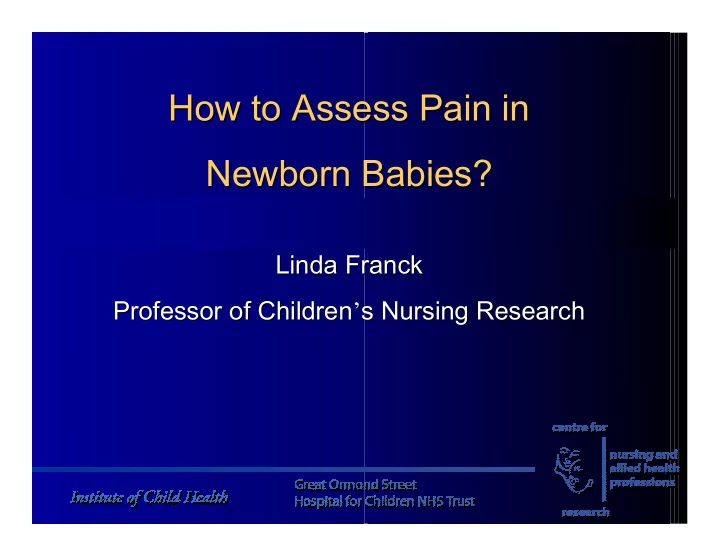

How to Assess Pain in How to Assess Pain in Newborn Babies? Newborn Babies? Linda Franck Linda Franck Professor of Children ’ ’ s Nursing Research s Nursing Research Professor of Children
Aims of this presentation Aims of this presentation • The history of infant pain assessment • Current knowledge and knowledge gaps • Implications for treatment of pain • Implications for research on pain medicines
Measuring pain… Measuring pain… …is ‘monkey business’ …is ‘monkey business’
Measuring pain in children Measuring pain in children What we’ve learned? � Just ask � Children can do it – Developmentally appropriate tools � Even infants can do it – Indirect measures
What do we know? What do we know? � In healthy and moderately ill infants brief acute pain can be accurately and reliably detected using: – Behaviour – Cardio-respiratory signs – Stress hormone levels
Infant pain measures: Infant pain measures: Cardio-respiratory Neuroendocrine and Autonomic Cortisol Heart Rate Catecholamines Blood pressure Beta-endorphin Respiratory Rate Glucose Behavioural O 2 saturation Insulin Facial action Palmar sweat Nitrogen balance Body movement Skin blood flow Vocalisation Heart rate variability Sleep Feeding
Limitations of Limitations of indirect pain measures indirect pain measures � Do not measure pain (nociception) per se � Measure intensity of – Pain-related distress – Pain reactivity � Are influenced by contextual factors – Previous pain – Level of arousal
Indirect pain measures can Indirect pain measures can also detect… also detect… � Response to treatment – Non-pharmacological – Pharmacological
Response to non- - Response to non pharmacological treatments pharmacological treatments Heel Puncture Intervention Mean PIPP Control 9.81 Prone 10.28 Pacifier w/ water** 8.47 Pacifier w/ sucrose** 7.86 Stevens, Johnston, Franck, et al, Nurs Res , 1999 Pacifier w/ water 10.19 Sucrose alone** 9.77 Pacifier w/ sucrose** 8.16 Gibbins, Stevens, Hodnett, et al, Nurs Res , 2002
Abdominal skin reflex Abdominal skin reflex � ASR useful in mapping intensity and location of wound hypersensitivity � ASR detected referred visceral pain � ASR responsive to changes in analgesia Andrews K, Fitzgerald M. Pain 2002; Andrews et al., Pain 2002
NEOPAIN Lancet 2004 NEOPAIN Lancet 2004 Morphine infusion n=244/446 Placebo infusion n=201/444
Pain scores and postoperative Pain scores and postoperative morphine requirements morphine requirements � COMFORT score (Bouwmeester 2003; 2001; van Dijk 2002) - Infants < 7 days required less - Less epinephrine/norepinephrine response - No difference intermittent vs bolus � NIPS/VAS (Simons 2003) - No difference between morphine and placebo groups
Procedural pain and stress during Procedural pain and stress during the early postoperative period the early postoperative period L. Franck. R. Howard, A. Aynsley L. Franck. R. Howard, A. Aynsley- -Green Green • Pre and 3 min post-procedure (pain and stress) • Pain scores, C-R, plasma cortisol, morphine levels
Procedural pain Procedural pain Stressful procedures (n=12): Stressful procedures (n=12): nappy care re-positioning mouth-care endotracheal suction Painful procedures (n=18): chest drain removal
Mean change pre- -post procedure post procedure Mean change pre 20 15 10 ** ** 5 * ** ** 0 COMFORT PIPP CRIES CHIPP LF HRV HF HRV HR mBP -5 Mean+SE Painful procedure ** significance > 0.01 -10 * Mean+SE Stressful procedure significance > 0.05 -15 Measure
Preliminary findings Preliminary findings • Pain scores and mBP discriminated between responses to painful and stressful procedures in critically ill infants following cardiac surgery • Pain scores are highly correlated; C-R parameters are highly correlated • Few associations found between pain scores and C-R parameters • Post-CDR pain scores inversely correlated with pre-procedure analgesia
Assessment of Adverse Effects Assessment of Adverse Effects � Poor data on prevalence and risk factors � Rarely the primary outcome variable in research � Poor quality measures
Implications for pain treatment Implications for pain treatment � Pain treatment decisions are subjective and not based on routine standardised assessment � Evaluation of the effectiveness of pain treatment decisions does not routinely occur � Inability to distinguish between effects of sedatives and analgesics � Pain treatment is not evidence-based
Implications for research on Implications for research on pain medicines pain medicines � Endpoints of pain assessment remain undefined � Sensitivity and specificity need to be improved � Analgesic and sedative effects must be distinguished � Measures of important side effects of analgesia must be developed
Conclusions 1 Conclusions 1 � Should we bother with pain assessment in babies? � Yes-established validity of some tools for some situations � Yes-importance for communication and audit
Conclusions 2 Conclusions 2 Which measures? CRIES CHIPP � Whichever one Cortisol clinicians will use!! COMFORT PIPP AND use to make HRV decisions about HR,BP,RR treatment %SaO2 � Careful use of sedatives alone
Acknowledgements: Acknowledgements: • Medical Research Council, UK • WellChild • Judy Peters, Alison Allen, Rosemary Bowers, Ira Winter • The staff of Ladybird Ward, DJW and CICU at Great Ormond Street Hospital for Children NHS Trust • Families and infants who have participated
Recommend
More recommend